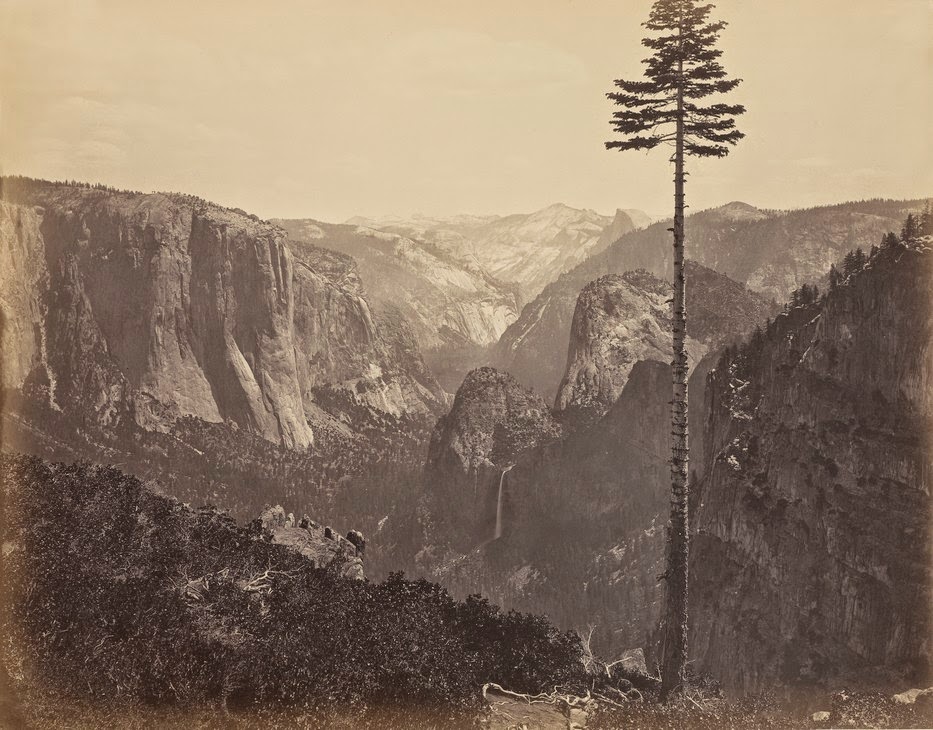Museo Sorolla Fondos fotógraficos. Carleton Watkins. 34 Mammoth photo. 45 x 55 cm.Sorolla' Museum.Madrid. Collection photo. Yosemite Carleton Watkins
Cuando uno hace un informe, a veces,es bueno empezar por el final.
Esto es lo que yo hago en esta ocasión.
Museo Sorolla. Son ustedes un magnífico museo y lo que es más, un museo muy agradable de ver, pasear de ESTAR.
Pues bien tienen ustedes Sorollas pero .....también veo que tienen estas joyas de la historia de la fotografía.
- Carleton Watkins. 34 Mammoth photo. 45 x 55 cm
¿Y si las exponen temporalmente?
¿Y si, sencillamente, las cuelgan temporalmente todo a lo largo y ancho de las paredes del Museo, ?
Pienso que a Sorolla le hubiera gustado.
“Amigo buenísimo mío. Hoy llegaron a mi poder las hermosas fotografías de California, son un acicate enérgico, hay que pintar América!!”211
Tarjeta postal conservada en la Hispanic Society of America de Joaquín Sorolla en Madrid a Archer Milton Huntington con fecha de diciembre de 1909, publicada en VV.AA. (1998), p. 383.
Las tesis doctorales estan acercándose a la fotografía de igual o parecida manera que lo han hecho con la pintura.
Acabo de encontrar en la web una francamente buena.....pero tesis es decir muy amplio documento de 307 páginas dedicada a la fotografía y a Sorolla.
Es decir Sorolla como artista, aficionado, y la influencia o relación que tuvo la fotografía en su modo de realizar o ver la pintura.
Tesis Doctoral SOROLLA Y LA FOTOGRAFÍA
Roberto Díaz Pena
Roberto Díaz Pena
Repito que es largo pero de amena lectura y, desde luego, se aprende leyendo este texto.
Destaquemos, opinión personal, los apartados siguientes
2.2 EL ACTO FOTOGRÁFICO
2.2.1 Realismo pictórico & realismo fotográfico ------------------------------------------------------ 100
2.2.2 El ojo fotográfico de Sorolla ------------------------------------------------------ 128
2.2.3 El debate norteamericano ------------------------------------------------------ 135
2.2.4 La fotografía como documento del proceso creativo ------------------------------------------------------ 148
2.2.1 Realismo pictórico & realismo fotográfico ------------------------------------------------------ 100
2.2.2 El ojo fotográfico de Sorolla ------------------------------------------------------ 128
2.2.3 El debate norteamericano ------------------------------------------------------ 135
2.2.4 La fotografía como documento del proceso creativo ------------------------------------------------------ 148
Y ahora veamos una sorpresa como aficionado a la fotografía antigua que veo en la página 186:
En el archivo fotográfico reunido por Sorolla encontramos una serie de fotografías que realizan este juego y que debieron de llamar profundamente la atención del artista al realizar una serie de obras desde un punto de vista similar. Entre ellas hay que destacar las del fotógrafo norteamericano Carletone E. Watkins del Parque Nacional de Yosemite en California tomadas entre 1861 y 1865, utilizando una cámara de gran formato que proporcionaba negativos de 45 x 55 cm denominados mammoth. Estas fotografías tuvieron una gran difusión al mostrar por primera vez un paisajeprácticamente virgen. En diciembre de 1861 Watkins mostró estos positivos en la prestigiosa Goupil´s Gallery de Nueva York y en 1863 publicó el álbum Yo-semite Valley: Photograpic Views of the Falls and Valley
Se conservan en total un conjunto de 34 positivos a la albúmina realizados a partir de negativos al colodión húmedo dimensiones del negativo de formato mammoth de 45 x 55 cm, adheridos a un soporte secundario de cartón como elemento de protección
Yosemite [Fig. 162], siendo el Museo Sorolla uno de los pocos del mundo en albergar tal cantidad de imágenes del fotógrafo debido a que su estudio quedo destruido durante el terremoto de San Francisco de 208 El conjunto de fotografías de Carletone E.
del Museo Sorolla tienen los números de inventario del 84119 al 84152.
Yosemite [Fig. 162], siendo el Museo Sorolla uno de los pocos del mundo en albergar tal cantidad de imágenes del fotógrafo debido a que su estudio quedo destruido durante el terremoto de San Francisco de 208 El conjunto de fotografías de Carletone E.
del Museo Sorolla tienen los números de inventario del 84119 al 84152.
Es decir, tiene este museo una serie de lo que en USA consideran uno de los primeros hitos de la fotografía de paisaje, de la fotografía documental y de la fotografía que sirvió para hacer historia pues gracias a estas fotos o merced a la existencia de estas fotos se pudo presentar en el Congreso Americano la propuesta, que fue aceptada, de convertir a Yosemite en parque nacional.
Son ademas fotos de formato mamoth, es decir fotos de 1861 de 45x55 cm. fotos que los aficionados rara vez veremos en Madrid, en España de tal tamaño, calidad y antigüedad a la vez
